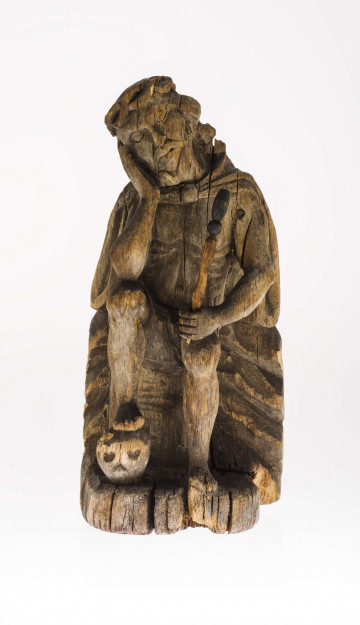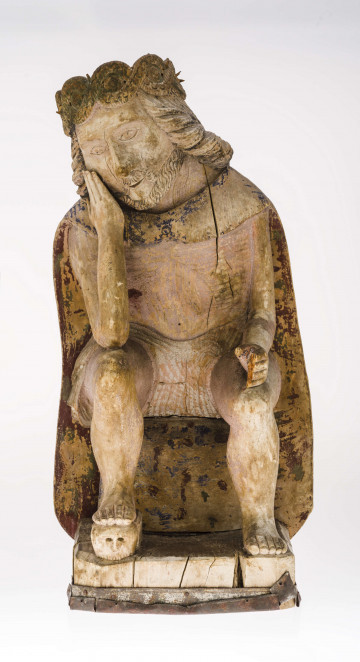
Pensive Christ
1801 — 1850
National Museum in Lublin
Part of the collection: Folk Art of the Lublin Region (17th–1st half of the 20th c.)
The sculpture of Chrystus z duszą Maryi [Christ with the Soul of Mary] probably comes from a larger sculptural group. It is interesting because of the representation of the figure of Jesus, the shape of his facial features or his robes, but also because it is a sculpture. The theme of the Dormition of the Mother of God is mainly found in icon painting. In Christian art, it is a representation of Mary's death (Koimesis - falling asleep) surrounded by the twelve apostles and Christ taking her soul. Iconographic scheme began to appear at the end of the fifth century, drew inspiration from apocryphal writings. It took shape in Byzantine art in the 9th century, although the figure of Christ - initially absent from the scene - did not appear until the 12th century representations. And it was he who, despite the Marian character of the event, became the central figure. The son, often depicted in the company of angels, standing at his mother's bedside, holds her soul in his hands, usually only the left one, in the form of an infant in its wrappings, i.e. in a funeral sheet. He is also usually looking at Mary's body resting on an ornamental bed – a death-bed. The icon of the Dormition illustrates the change of roles: as a child, Mary carried Jesus in her arms, now he holds and caresses her soul; the Mother gave the Son earthly life, the Son gives the Mother eternal life. Western art adopted the Byzantine iconography, gradually modifying it, including showing Mary not asleep but dead, and linking the scene with that of the Assumption and, from the 13th century, the Coronation.
In Western art, the scene is called the Assumption of the Blessed Virgin Mary, in Eastern art it is called the Dormition of the Mother of God, because Orthodox theology distinguishes three facts of Mary's life: the death-dormition, the resurrection and the subsequent Assumption. Churches of both rites celebrate Marian feasts on the same day – 15 August (according to the Julian calendar, 28 August according to the Gregorian calendar). In the Orthodox liturgical year, this is the most important holiday in honour of Mary. It is preceded by two weeks of strict fasting, the requirements of which correspond to the Catholic Lent. On the eve of the holiday, an all-night vigil is held, which combines the supper, dawn and the first hour service.
Author / creator
Dimensions
cały obiekt: height: 115 cm
Object type
sculpture
Technique
sculpture
Material
wood
Creation time / dating
Creation / finding place
Owner
The National Museum in Lublin
Identification number
Location / status

1801 — 1850
National Museum in Lublin

1862
National Museum in Lublin

1894 — 1930
National Museum in Lublin
DISCOVER this TOPIC
Castle Museum in Łańcut
DISCOVER this PATH
Educational path